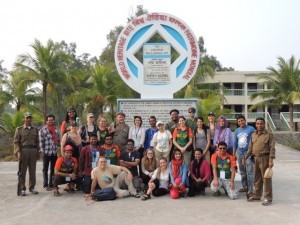Polder 32 and Hiron Point
We visited Polder 32, an embanked island in the delta that was flooded for almost two years when the embankment failed in several places during Cyclone Aila. In addition to the problem of increased subsidence due to the embankment, the area struggles for fresh water. Then we sailed to Hiron Point, a forest station in the Sundarbans, the world’s largest mangrove forest. We serviced equipment we have here while our armed guards watch for tigers.
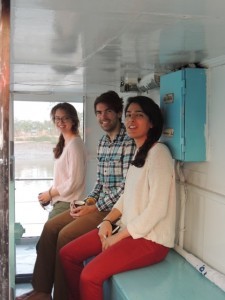
We sailed downstream to join the M/V Bawali with the Vanderbilt-Dhaka-Khulna group working on Bangladesh late at night and awoke to greet old friend and meet new ones. After breakfast, we all headed to Polder 32. Polder 32 is one of the islands that had embankments constructed around them to prevent flooding and improve agriculture. They use the Dutch term polder for the embankments. Polder 32 was one in which the polders failed during Cyclone Aila in 2009. As it turned out, while the polders improved agriculture as planned, it also led to subsidence of the island. It is now over 4 feet lower than land outside the island. This led to widespread flooding of the island after the cyclone that lasted for almost 2 years. We have been studying the causes and impact for the last few years. The subsidence inside the polders put everyone at risk as an unintended consequence of keeping out the natural flooding and sedimentation to improve agriculture. How to manage this system now is a difficult problem.
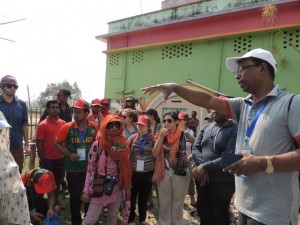
We also learned about the water problems at Polder 32. The groundwater is saline and not usable for either drinking or irrigation. They can only grow one crop a year, so the fields are all fallow except for some vegetable gardens by the homes. In other parts of Bangladesh 2 and even 3 crops a year are possible. We saw the abandoned tube wells installed by a wealthy donor after Cyclone Aila. They are all saline. Kazi Matin showed us his MAR site – managed aquifer recharge. They are attempting to create a pool of fresh groundwater over the heavier salt water providing a source of sweet water. Nearby, the Vanderbilt team is
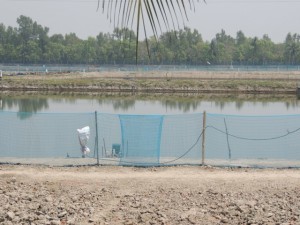
installing equipment to measure water levels and flow at different depths, trying to better understand the groundwater system.
While the students fanned out to discuss agriculture with the farmers and test what few tube wells they could find, a small group of us took a speed boat to a large industrial shrimp farm on Polder 33. We found the site to be surrounded by a barbed wire fence. We found out later that it is to protect the site from tigers as it is on a peninsula surrounded on 3 sides by the Sundarbans. There was a rumor that the shrimp farm had closed and could be used to calibrate remote sensing data, but it was fully running. They grow 2 crops of jumbo shrimp a year over 9 months and spend the
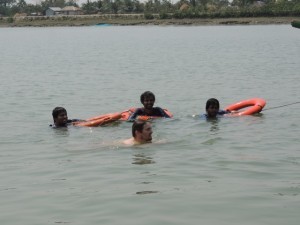
remaining 3 months cleaning the ponds and preparing for the next season’s crop. They were one of the first large-scale shrimp operations in Bangladesh.
We sped back to the ship to find that the others had all returned and were having a swim break. I barely managed to change into my swimsuit and jump in before we all had to return to the ship to sail to Hiron Point. The strong tides in southern Bangladesh set our schedule as we try to catch tides going our way and avoid sailing against the tide. We sailed down channel between Polder 32 and the Sundarbans to the Shibsa River. At the end we passed Kalibogi. It is a peninsula at the end of Polder 32 that has had about a kilometer of erosion. It is now very narrow and the
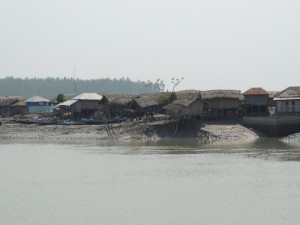
embankment has been moved north of the peninsula, abandoning it. The shrimp farms that were once here are gone. There are only homes poorly protected from the elements and fishing is their only livelihood.
We sailed down the Shibsa to the Pusur River and overnighted in a narrow channel across from Hiron Point. In the morning we crossed. This stop is manly for me to service our GPS installation. We are using the precise measurements to determine the subsidence rate of this part of the delta. There is a tide gauge here that monitors the relative level between the sea and the land. While intended for navigation, over time it records the combined effect of land subsidence and sea level rise. With the GPS, we will be able to separate the two rates.
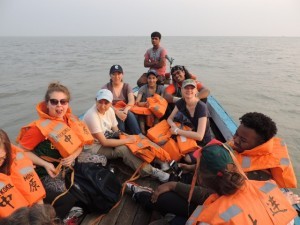
We all took the small wooden launch into the channel to the Forest Station. The Kokilmoni stayed outside lest it get trapped behind the mouth bar when the tide goes out. Hasnat and I, with Sabrina filming went to service the GPS while Liz demonstrated how to auger to get stratigraphy and sample for OSL dating. Small groups also took turns going up the observation tower. I discovered that I did not have my internet adapter – Apple have eliminated them from the newest Mac. I was stuck. Hasnat rushed back to the ship with the launch to get his computer. I could only wander around. I was shown the small spring with natural gas bubbling up. It could even be lit on fire. Finally Hasnat returned and we were able to download all the data since my last visit and upgrade the firmware of the receiver. We finished right at high time and rushed back to the ship to sail to our next stop. Thanks to Hasnat, we were able to accomplish our goals here.
